Try Default

See how revenue teams automate revenue operations with Default.

Key Takeaways
Key takeaways
- B2B sales KPIs should reflect how your team actually sells — not just what’s easy to measure. Tie metrics to funnel stages, performance outcomes, and decision points.
- Tracking fewer, more relevant KPIs leads to faster execution. The goal isn’t visibility — it’s focus, clarity, and action.
- A strong KPI layer covers the full GTM motion: top-of-funnel conversion, mid-funnel velocity, and post-sale retention.
- Predictive tools and AI are raising the bar. The most effective teams now act on real-time signals — not just end-of-quarter reports.
- Default helps revenue teams automate and operationalize their KPIs — connecting tools, enriching data, and making performance gaps visible as they happen.
Most teams don’t struggle because they lack data. They struggle because they aren’t sure which numbers to trust.
B2B sales KPIs are everywhere — dashboards, reports, weekly standups. But unless you’re tracking the right ones, it’s hard to know what’s really working. It’s even harder to improve.
This guide breaks down the 31 KPIs that actually help sales teams grow. Not just to measure outcomes, but to spot patterns, improve process, and make better decisions faster. We’ll walk through each category, explain what to track and why, and show how AI is starting to shift the landscape in 2025.
If you care about sales performance, this is the data that matters.
The 7 KPI categories every B2B sales team needs to track
Not all KPIs measure the same thing — and that’s the point.
Some track outcomes, others uncover bottlenecks, and a few help you predict what’s coming next. To make sense of it all, it helps to group your KPIs by function. Here are the seven core categories every B2B team should understand before choosing what to track.
Core revenue metrics
Start with the fundamentals. Revenue-focused KPIs tell you if your sales engine is actually converting. Whether it's closed-won deals, quota attainment, or average deal value, these metrics show if you're hitting plan — and whether your GTM motion is built to scale or just sprint.
Funnel conversion metrics
Pipeline tells a story. These KPIs help you track how leads progress from MQL to closed-won, where they stall, and why they drop. If you're generating pipeline but not booking revenue, conversion data helps pinpoint the breakdown and improve handoffs, messaging, or qualification criteria.
Activity and productivity metrics
More effort doesn’t always mean more pipeline. These KPIs measure the quality and volume of rep activity — emails, calls, meetings — so you can spot underperformance early, identify coaching opportunities, and ensure your team’s time is spent where it actually drives results.
Pipeline and forecasting metrics
Forecasting without deal-level insight is a gamble. These metrics help you assess pipeline health, movement, and velocity — so you’re not just projecting revenue, you’re pressure-testing it. They give leaders the clarity to course-correct before targets are missed, not after.
Customer lifecycle and retention metrics
The best B2B revenue teams don’t stop at closing. These KPIs track expansion, churn, and product adoption across the customer lifecycle. When used right, they help sales, success, and product stay aligned, and build compounding value from your existing base.
Sales efficiency and ROI metrics
Revenue matters, but efficiency tells you how sustainable it is. These KPIs look at ramp time, CAC, cost per rep, and sales cycle length to show how well you’re converting resources into results. Critical if you’re under pressure to do more with less.
Predictive and AI-driven metrics
As teams move faster and markets shift quicker, reactive reporting isn’t enough. Predictive KPIs use AI and machine learning to surface risk, identify high-likelihood deals, and spot patterns humans miss — giving you the edge in planning, prioritization, and performance.
Top 31 B2B sales metrics and KPIs to track
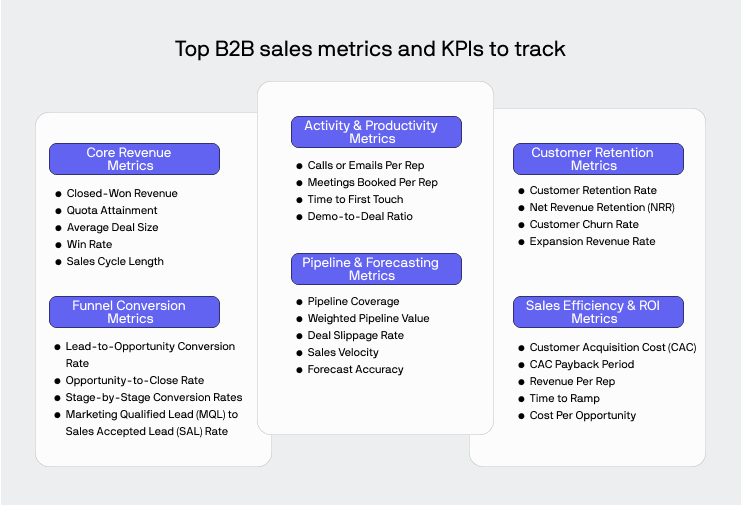
Core revenue metrics
These are the KPIs that answer the big questions: Are we closing enough? Are deals big enough? Are we hitting revenue targets? If these numbers are off, the rest of your sales process doesn’t matter — because it isn’t converting.
Closed-won revenue
- How it’s calculated: Total dollar value of all deals marked as "closed-won" within a given period.
- What success looks like: Revenue is consistently meeting or exceeding quota or forecast benchmarks.
- What it tells you: The clearest signal of whether your sales efforts are producing tangible results. If this is low, you’re either not closing enough or not closing the right deals.
Quota attainment
- How it’s calculated: Percentage of reps who meet or exceed their sales quota within a defined time period.
- What success looks like: 70–80%+ of reps hitting quota is generally healthy. Below 50% often points to systemic issues.
- What it tells you: Whether targets are realistic, the team is executing effectively, and compensation plans are aligned with sales potential.
Average deal size
- How it’s calculated: Total revenue from closed-won deals ÷ number of closed-won deals.
- What success looks like: Deal size is stable or growing — especially if you’re moving upmarket or focusing on enterprise.
- What it tells you: Shifts in ACV can signal strategic changes, pricing issues, or changes in buyer behavior. Helps with pipeline planning and forecasting accuracy.
Win rate
- How it’s calculated: Number of closed-won deals ÷ total number of deals in a given period.
- What success looks like: 20–30%+ is typical for well-qualified pipeline. Much lower may point to poor qualification or lack of competitive differentiation.
- What it tells you: How effective your team is at converting pipeline into revenue. A leading indicator of both process quality and deal execution.
Sales cycle length
- How it’s calculated: Average number of days from initial contact to closed-won.
- What success looks like: Depends on ACV and sales motion — but shorter cycles generally mean better velocity and higher rep efficiency.
- What it tells you: Whether deals are moving at a healthy pace. Long or inconsistent cycles can signal internal delays, poor qualification, or buyer hesitation.
Funnel conversion metrics
If pipeline is building but not converting, something’s broken in your funnel. These KPIs show how leads move through each stage of the buyer journey and where friction is killing momentum. They're essential for diagnosing leaks, fixing handoffs, and aligning sales and marketing.
Lead-to-opportunity conversion rate
- How it’s calculated: Number of leads that become qualified sales opportunities ÷ total number of leads.
- What success looks like: Varies by channel and ICP — but 10–20% is common for inbound, lower for outbound.
- What it tells you: How well your team is qualifying and developing early-stage leads. If this is low, you may have a targeting, messaging, or SDR execution issue.
Opportunity-to-close rate
- How it’s calculated: Number of closed-won deals ÷ total number of qualified opportunities.
- What success looks like: 25–35% is strong in most B2B cycles. Lower suggests deals are stalling late or you're qualifying too loosely.
- What it tells you: How effective your reps are at managing deals once they enter the pipeline. A low rate means great leads are going to waste.
Stage-by-stage conversion rates
- How it’s calculated: Percentage of deals that move from one stage to the next across your sales process.
- What success looks like: Consistent drop-offs between 10–30% per stage depending on cycle length and deal complexity.
- What it tells you: Where deals are getting stuck. Sharp drop-offs at specific stages reveal problems with buyer alignment, rep process, or value messaging.
Marketing qualified lead (MQL) to sales accepted lead (SAL) rate
- How it’s calculated: Number of MQLs accepted by sales ÷ total MQLs delivered.
- What success looks like: 60–90%+ in well-aligned orgs. Anything below 50% indicates major disconnect between sales and marketing.
- What it tells you: How tightly your sales and marketing teams are aligned on lead quality, timing, and intent.
Activity and productivity metrics
More pipeline starts with better motion. These KPIs track what your sales team is doing day-to-day — calls, emails, meetings, demos — and how that activity translates into results. They help leaders separate busy work from effective work and drive rep accountability without micromanaging.
Calls or emails per rep
- How it’s calculated: Number of outbound calls or emails sent per rep within a defined period.
- What success looks like: Benchmarks vary, but consistency across high performers sets the bar.
- What it tells you: A basic, but necessary, volume indicator. If activity is low, don’t expect pipeline. If it’s high with no results, you may have a quality issue.
Meetings booked per rep
- How it’s calculated: Number of qualified meetings (e.g. discovery, demo, or intro calls) scheduled by each rep.
- What success looks like: Depends on sales motion, but typically 10–15 meetings/month is a baseline for outbound.
- What it tells you: A leading indicator of pipeline creation. Helps evaluate SDR/BDR effectiveness and the quality of outbound messaging.
Time to first touch
- How it’s calculated: Average time between a lead entering the CRM and the first rep interaction (call, email, message).
- What success looks like: Best-in-class teams respond within minutes. Anything over 24 hours can significantly reduce win rate.
- What it tells you: How responsive your team is to new leads. Delays here often mean missed opportunities — especially in competitive spaces.
Demo-to-deal ratio
- How it’s calculated: Number of demos held ÷ number of closed-won deals.
- What success looks like: A lower ratio (i.e. fewer demos per deal) usually signals better qualification and demo execution.
- What it tells you: How effective your demo process is. High ratios suggest wasted time on unqualified leads or underwhelming demos.
Pipeline and forecasting metrics
Revenue planning lives or dies on visibility. These KPIs show you the size, quality, and velocity of your pipeline, so you can forecast accurately, coach reps more effectively, and prevent prevent deals from stalling or quietly going dark late in the cycle.
Pipeline coverage
- How it’s calculated: Total open pipeline for a given period ÷ sales target for that same period.
- What success looks like: 3–5x coverage is typical for most B2B teams, depending on win rate and cycle length.
- What it tells you: Whether you have enough pipeline to hit your number. If this is consistently low, you’re flying into the quarter already behind.
Weighted pipeline value
- How it’s calculated: Sum of all open deals multiplied by their probability to close (based on deal stage).
- What success looks like: A more realistic version of pipeline value that adjusts for deal risk. Should closely align with forecasted revenue.
- What it tells you: A truer picture of likely outcomes — not just potential. Helps avoid overreliance on high-risk or late-stage deals.
Deal slippage rate
- How it’s calculated: Number of deals that were forecasted but didn’t close as planned ÷ total forecasted deals.
- What success looks like: Lower is better. Under 20% slippage shows discipline in forecasting and deal management.
- What it tells you: Whether reps are accurately assessing deal timing — and how much you can trust your forecast.
Sales velocity
- How it’s calculated: (Number of opportunities × win rate × average deal size) ÷ average sales cycle length.
- What success looks like: Growth over time, especially if deal size and win rate increase while cycle time shortens.
- What it tells you: A composite metric showing how quickly you’re generating revenue. Useful for spotting inefficiencies in your GTM engine.
Forecast accuracy
- How it’s calculated: (Actual revenue ÷ forecasted revenue) × 100
- What success looks like: 90%+ accuracy at the leadership level. Lower numbers signal rep overconfidence or lack of data hygiene.
- What it tells you: Whether your team’s forecast can be trusted. Critical for planning headcount, spend, and board expectations.
Customer lifecycle and retention metrics
Revenue doesn’t stop at closed-won. These KPIs help you measure what happens after the deal — from onboarding and usage to renewals and expansion. If you care about net revenue retention or building a land-and-expand motion, this is where the real signals live.
Customer retention rate
- How it’s calculated: (Number of customers at end of period – new customers acquired) ÷ customers at start of period.
- What success looks like: 90%+ annual retention in B2B is strong. Lower numbers in SMB or usage-based models may be normal, but should be improving.
- What it tells you: Whether your solution is sticky. Falling retention usually means poor onboarding, product-market fit issues, or weak handoffs post-sale.
Net revenue retention (NRR)
- How it’s calculated: (Recurring revenue from existing customers + expansions – churn – downgrades) ÷ starting revenue from those customers.
- What success looks like: 110–130%+ is strong in SaaS. Anything below 100% means revenue is leaking.
- What it tells you: Whether your existing customer base is growing or shrinking in value. A top-line predictor of long-term health.
Customer churn rate
- How it’s calculated: Number of customers lost in a period ÷ total customers at start of that period.
- What success looks like: Lower is better, of course, with under 5% monthly churn being solid in most B2B markets.
- What it tells you: A lagging but vital signal. High churn often reflects sales bringing in the wrong fit, or post-sale gaps in delivery or support.
Expansion revenue rate
- How it’s calculated: Revenue from upsells, cross-sells, and add-ons ÷ total revenue from existing accounts.
- What success looks like: Higher ratios point to a strong customer success motion and product depth.
- What it tells you: Whether your sales and CS teams are effectively growing accounts after the initial sale. Helps assess the maturity of your expansion strategy.
Sales efficiency and ROI metrics
Scaling a sales org isn’t just about adding headcount — it’s about improving output per dollar, per hour, per rep. These KPIs help you understand whether your GTM motion is efficient, whether your budget is working, and where revenue is being lost to drag, delays, or bloat.
Customer acquisition cost (CAC)
- How it’s calculated: Total sales and marketing spend ÷ number of new customers acquired.
- What success looks like: CAC should fall as you scale and improve efficiency. High CAC is only acceptable if paired with strong LTV.
- What it tells you: How much it costs to land a new customer. If it’s rising, you're spending more to achieve the same results — a red flag for GTM fit or team efficiency.
CAC payback period
- How it’s calculated: CAC ÷ average monthly recurring revenue per customer.
- What success looks like: Under 12 months is a strong benchmark in SaaS. Anything over 18 months raises cash flow concerns.
- What it tells you: How long it takes to recoup the cost of acquiring a customer. Critical for runway, capital efficiency, and growth planning.
Revenue per rep
- How it’s calculated: Total revenue ÷ number of quota-carrying reps.
- What success looks like: Rising over time with rep maturity and improved process.
- What it tells you: A pulse check on rep productivity. Helps identify if you're over- or under-staffed relative to pipeline and bookings.
Time to ramp
- How it’s calculated: Average time it takes for new reps to hit full quota consistently.
- What success looks like: 3–6 months in most B2B orgs. Longer than that drains budget and slows scaling.
- What it tells you: Whether your onboarding, enablement, and hiring strategy are setting reps up to succeed — or just survive.
Cost per opportunity
- How it’s calculated: Total spend (sales + marketing) ÷ number of qualified opportunities created.
- What success looks like: Declining over time as targeting improves and workflows become more efficient.
- What it tells you: How efficiently your team generates pipeline. Use this to evaluate campaign ROI, channel performance, or outbound strategy.
Predictive and AI-driven metrics
The most effective sales teams don’t just report what happened, they predict what’s next. These KPIs use AI, machine learning, and behavioral data to forecast pipeline risk, prioritize deals, and surface revenue opportunities faster than a spreadsheet ever could.
Deal risk score
- How it’s calculated: AI model that factors in deal age, activity patterns, engagement levels, and historical outcomes.
- What success looks like: High-risk deals are flagged early, allowing for timely intervention or reallocation of focus.
- What it tells you: Which deals are most likely to slip — and why. Helps leaders coach proactively and avoid surprise losses late in the cycle.
Predictive close rate
- How it’s calculated: Machine learning model that assigns a probability of close based on historical patterns and real-time behavior.
- What success looks like: Close predictions align closely with actual outcomes, improving forecast accuracy.
- What it tells you: Which deals are worth doubling down on. Helps reps prioritize effectively and supports smarter resourcing decisions.
Intent signal engagement
- How it’s calculated: Aggregates behavioral data (e.g. content views, repeat site visits, email opens) across buying committees.
- What success looks like: Spikes in intent data trigger faster follow-up and tighter targeting.
- What it tells you: Which accounts are heating up before they raise their hand. Helps shift from reactive to proactive outreach.
AI-powered pipeline forecasting
- How it’s calculated: Combines CRM data, rep behavior, and deal history to project future revenue.
- What success looks like: More accurate forecasts with less manual effort — especially useful across multi-rep, multi-geo teams.
- What it tells you: Whether you’re on track to hit plan — before the end-of-quarter scramble. Makes forecasting more scalable and less subjective.
What counts as a B2B sales KPI — and what doesn’t
B2B sales KPIs (key performance indicators) are the metrics that measure how effectively your sales team is driving revenue. Unlike surface-level activity metrics, these KPIs focus on conversions, efficiency, and outcomes that align with your go-to-market strategy.
Used well, they help you coach with context, forecast with confidence, and ensure every motion is tied to commercial impact.
Why your sales KPIs shape more than just reporting
- They create alignment across GTM teams
KPIs give sales, marketing, and success a shared language — making it easier to diagnose what’s working, where deals are stalling, and what needs to change. - They turn gut feel into actionable insight
Without KPIs, sales management becomes anecdotal. With them, you can coach reps, forecast revenue, and evaluate pipeline with real data. - They make performance scalable
Tracking the right KPIs helps you spot repeatable behaviors, design better onboarding, and scale what works — without reinventing process every quarter. - They expose inefficiency and drag
KPIs reveal where time and resources are being wasted — whether it's bloated cycles, low-quality leads, or inconsistent rep output.
Taken together, they help leadership make sharper decisions, move faster, and focus execution where it drives the most revenue impact.
How to choose sales KPIs that actually improve performance
You don’t need more metrics — you need the right ones tied to how your team sells and how your business grows. These are the lenses revenue leaders use to separate noise from signal and build a reporting layer that actually drives performance.
Align with your sales model
What works for a high-volume SDR team won’t fit a strategic, multi-threaded enterprise motion. Start by mapping KPIs to how you actually sell — including deal size, cycle length, buyer journey, and team structure. The goal is to reflect real performance, not just check boxes.
Prioritize outcomes over activity
Volume metrics (calls, emails, meetings) are easy to track. And just as easy to misuse. Instead of measuring motion, prioritize KPIs tied to results: qualified pipeline, close rates, retention. These show whether activity is moving the needle, not just filling reports.
Focus on leading and lagging indicators
Lagging metrics tell you what happened. Leading indicators help you course-correct before it’s too late. A healthy KPI mix includes both — so you’re not just reviewing history, but actively steering toward better outcomes.
Limit your core KPIs
Too many metrics dilute focus. Zero in on 5–7 core KPIs that tie directly to growth, efficiency, and forecast confidence. Everything else can live in dashboards — but your core KPIs should guide weekly meetings, 1:1s, and planning cycles.
The goal isn’t just clean reporting — it’s driving accountability, speed, and better decisions across the revenue org. Get the KPIs right, and everything downstream runs tighter.
The tools that make KPI tracking scalable, not messy
Tracking KPIs shouldn’t be a manual patchwork of exports and duct-taped dashboards. The right tools give you signal in real time — without chasing data across tabs. Here are the platforms that matter most.
CRM platforms (e.g. Salesforce, HubSpot)
Your CRM is the foundation, but only if it's configured correctly. It should capture key metrics at every stage of the funnel and integrate tightly with marketing and success. Don’t just store data here — use it to drive forecasting, coaching, and revenue visibility.
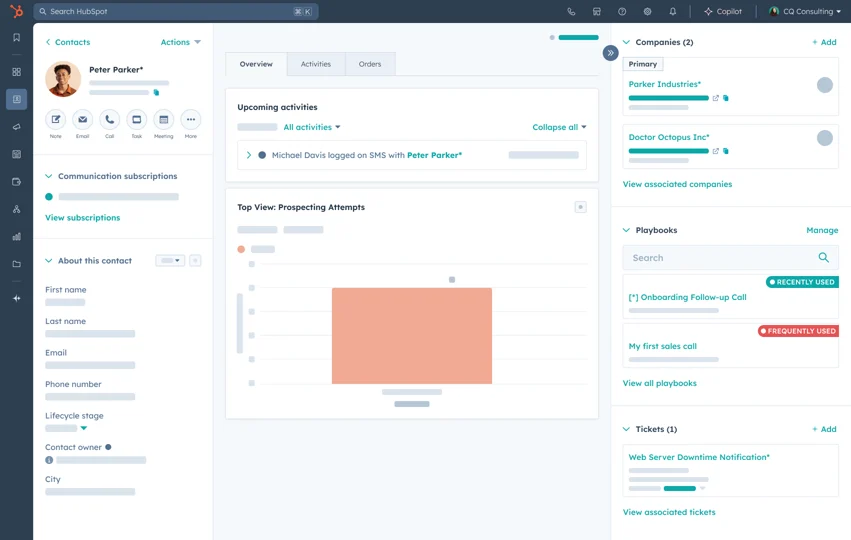
Courtesy of Hubspot
BI and reporting tools (e.g. Looker, Tableau)
For teams managing multiple data sources, BI tools offer the flexibility to build custom dashboards, blend inputs, and run deeper cohort analysis. Best suited for ops teams that need to answer more complex questions than a CRM can handle natively.
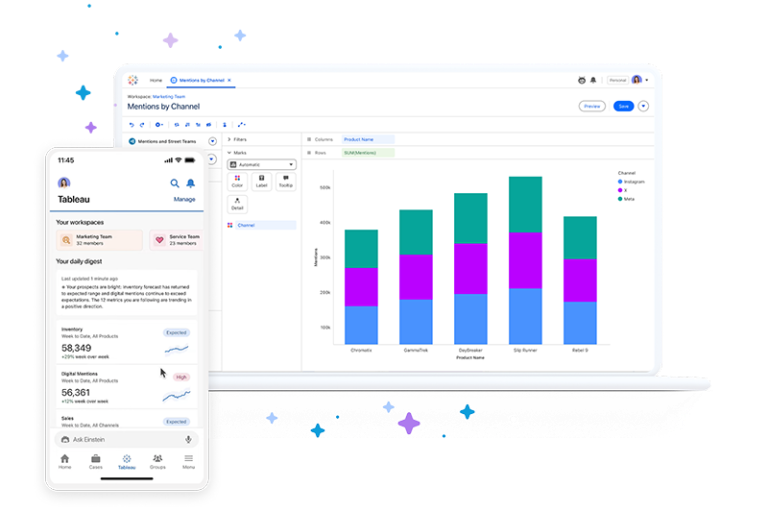
Courtesy of Tableau
Sales performance platforms (e.g. Gong, Clari)
Platforms like Gong and Clari add a predictive layer — surfacing deal risk, rep activity, and forecast accuracy through real-time analysis. These tools help sales leaders stay ahead of problems and shift from lagging reviews to proactive decision-making.

Courtesy of Gong
Enablement and productivity tools (e.g. Outreach, Salesloft)
While not reporting tools per se, these platforms generate data that feeds core KPIs — especially around rep activity, cadence performance, and conversion rates. They also help enforce consistency across your motion, which improves KPI reliability.
Automation and intelligence layers (e.g. Default)
Default does more than centralize reporting — it turns KPI insights into action. It connects your GTM data, enriches buyer signals in real time, and routes leads to the right reps based on fit, urgency, and intent. That means faster speed-to-lead, cleaner dashboards, and a KPI layer built for execution — not just visibility.

The tech stack you choose shapes how fast you can spot risk, how well you coach, and how confidently you plan. Invest in tools that reduce noise and surface the metrics that actually move revenue forward.
Where sales KPI tracking goes wrong — and how to fix it
Even the best metrics won’t help if the process around them is flawed. These are the most common traps that throw off data quality, waste time, and lead to the wrong decisions.
Tracking too many KPIs
Trying to measure everything usually means acting on nothing. Stick to the metrics that drive decisions — not just the ones that are easy to track. Secondary data can support deeper analysis, but it shouldn’t crowd your core performance view.
Confusing activity with performance
High output doesn’t equal high impact. Logging calls and emails is easy; converting them is hard. Don’t mistake motion for momentum — always tie activity metrics back to pipeline creation and deal progression.
Using lagging indicators only
If you’re only looking at closed revenue, you’re already behind. Without leading indicators — like conversion rates, rep activity, and velocity — you can’t see problems until it’s too late to fix them. Balance historical results with real-time signals.
Measuring KPIs without clear ownership
Metrics without owners don’t move. Assign every KPI to a team, role, or meeting — and define what “good” looks like. This ensures accountability and turns reporting into action, not just observation.
Relying on static dashboards
Dashboards are snapshots. But sales performance is dynamic. If you’re not reviewing KPIs regularly and adjusting based on what you see, the data becomes background noise. Build feedback loops, not just reports.
Poor KPI hygiene doesn’t just skew reporting — it leads to misaligned targets, wasted effort, and missed numbers. The difference between teams that scale and teams that stall often comes down to how seriously they treat their metrics.
Using KPIs to shape GTM strategy: a step-by-step playbook
When KPIs are wired into how you make decisions — not just how you report them — everything sharpens. Planning gets clearer, coaching gets faster, and GTM execution starts to feel like a system instead of a scramble.
1. Map KPIs to funnel stages
Start by aligning specific KPIs to each part of your revenue funnel — from lead gen to expansion. This gives you visibility into where performance is strong, where it’s stalling, and what to fix first.
Example:
- Top of funnel: lead-to-opportunity rate
- Mid-funnel: win rate, sales velocity
- Post-sale: NRR, churn rate
2. Set baseline performance benchmarks
Before you set targets, know your current reality. Use historical data to benchmark each KPI by team, segment, and channel. This gives you a grounded starting point for setting quotas, budgets, and forecasting inputs.
3. Identify your growth levers
Once baselines are clear, pressure-test your model. Ask:
- What happens if we improve win rate by 5%?
- What’s the impact of reducing time-to-first-touch?
- Where’s the biggest drop-off in our funnel?
Use KPIs to spot leverage points, then build campaigns, coaching, or tooling around them.
4. Tie KPIs to team accountability
Every KPI should have a clear owner — rep, manager, or ops — and be reviewed regularly in 1:1s, team meetings, and forecast calls. This turns your GTM motion into a system, not a series of isolated efforts.
5. Iterate monthly, not quarterly
Markets shift faster than quarterly reviews can keep up. Revisit KPI performance monthly to spot early signals (and adapt faster than competitors still locked in QBR cycles).
This isn’t about building prettier dashboards. It’s about pressure-testing your strategy, spotting bottlenecks early, and making sharper GTM bets. The teams that win don’t just track KPIs — they build systems that respond to them.

How AI is changing the way B2B teams use sales KPIs
AI is reshaping how GTM teams use sales KPIs — not just by automating reporting, but by adding context and foresight. Predictive models analyze historical patterns, real-time engagement, and rep behavior to flag risk, surface high-likelihood deals, and spot pipeline gaps early. That means leaders aren’t waiting for end-of-quarter reports to adjust; they’re course-correcting mid-cycle.
AI also helps declutter dashboards by highlighting only the metrics that need action. When done right, this shifts KPIs from passive indicators to dynamic signals that drive smarter, faster decisions — across sales, marketing, and customer success.
Track less, sell more – automate B2B sales KPIs with Default
If your KPIs live in disconnected tools and dusty dashboards, you’re already behind.
Default changes that.
It unifies your GTM data, enriches every lead in real time, and auto-routes it to the right rep — based on ICP fit, urgency, and pipeline gaps.
Your KPIs don’t just sit in a report — they trigger action.
No more stale reporting. No more missed handoffs. Just cleaner execution, faster decisions, and full-funnel visibility — without the spreadsheet gymnastics.
Book your interactive demo to see how Default turns live sales data into real-time GTM performance.
Conclusion

Former pro Olympic athlete turned growth marketer! Previously worked at Chili Piper and co-founded my own company before joining Default two years ago.
Accelerate your growth with Default.
Revamp inbound with easier routing, actionable intent, and faster scheduling















.png)


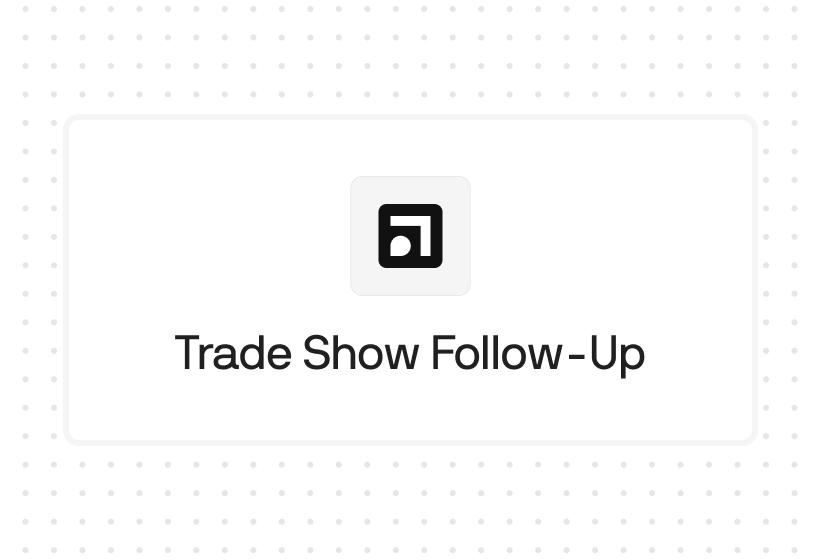
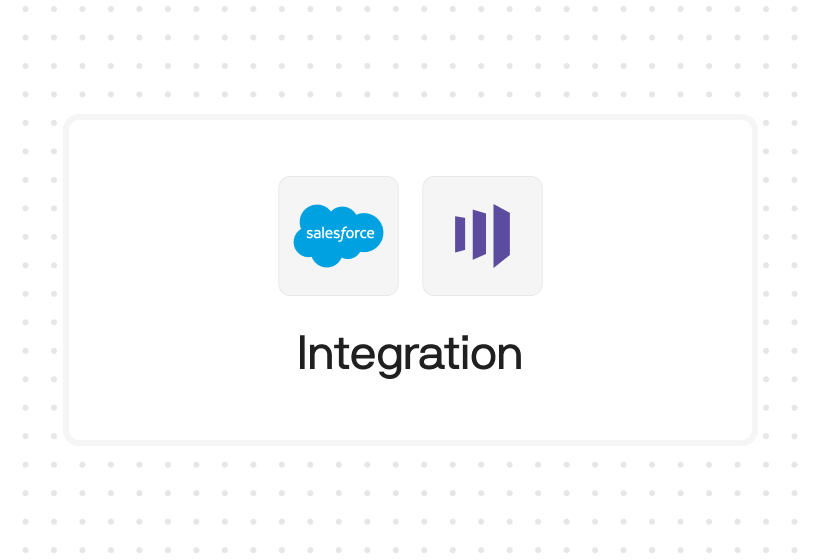




%201.svg)



.svg)





%201.svg)



%201.svg)

